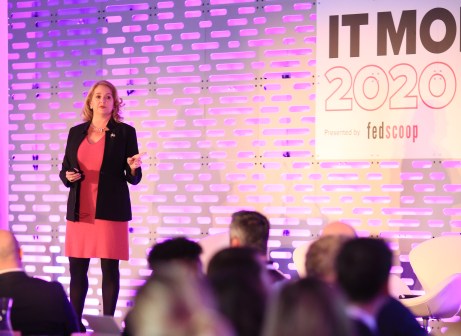How the ‘New IP’ can help federal agencies
As the federal government looks to harness the best of emerging enterprise architecture, its current network presents considerable hurdles. Innovations like cloud, big data and the Internet of Things call for a network that is fast, flexible and able to adapt to rapidly changing needs.
Brocade calls such a network the “New IP.” The company showcased some of technologies that make the New IP possible Wednesday during its Federal Forum, which was produced by FedScoop. Several Brocade leaders at the event said the New IP could help agencies reduce their network costs and become more agile in a changing technology landscape.
During a keynote at the forum, Phil O’Reilly, Brocade’s federal chief technology officer, said the way the government procures and carries out its IT functions is unsustainable from a cost and technological perspective.
“We have made a mistake in consolidating and concentrating our focus in the various elements of delivering this user experience to the American citizen,” O’Reilly said. The government spends at least 70 percent of its IT budget on legacy systems, he said. “That needs to change. That changes by making the infrastructure more flexible, more able to be adaptive continuously, without having to make a wholesale change to your network.”
According to Brocade, a key part of the New IP is software-defined networking, or SDN, which is already in place in some agencies. The underlying technologies that make SDN possible are what makes Amazon Web Services, virtual machines and hypervisors possible.
“You’ve already embraced this change,” O’Reilly said to federal government officials attending the event.
It’s a change that government IT personnel see as necessary. In a survey released at the forum, less than 15 percent of respondents felt their agency’s current network infrastructure will be able to support their future missions. Additionally, 70 percent of respondents are considering, planning or have already moved to SDN, citing performance and ease of management as major advantages.
O’Reilly said SDN allows agencies to cut costs while delivering citizen experiences the public is growing to expect.

Brocade Federal Chief Technology Officer Phil O’Reilly. (FedScoop)
“This is not a rock and a hard place anymore,” he said. “We are giving you an option to consider technology that can solve problems in a brand-new way, giving you efficiency and cost reduction.”
Aside from citizen services, O’Reilly said this new software is crucial for warfighters, who are consistently in the field with an array of sensors that deal with everything from health monitoring to communication capabilities.
“Think about the ramifications as that data runs upstream on these creaky, rigid, topologically dependent, capacity-planned networks that we have in place,” he said. “If the New York Stock Exchange drops some packets, someone loses some money. When this network drops packets, somebody dies.”
Whether it is innovations related to the warfighter, the ability to bring cloud into a large agency or allowing the government to tap into the Internet of Things, Brocade sees SDN giving feds the opportunity to work in an agile, responsive network.
“The ultimate goal of this is to move workloads anywhere in your environment,” O’Reilly said. “And by workload, I mean application, data and network characteristics. Movement without impunity. That flexibility gives you the kind of scale that will allow you to work in a world where you cannot predict today what’s going to happen tomorrow.”
Additional reporting from the Federal Forum 2015:
Government needs agile networks, federal CIOs say – At Brocade’s Federal Forum, produced by FedScoop, IT leaders emphasized the need for flexible computing networks as the U.S. faces a mounting cyber threats.
Federal IT isn’t keeping up with new technology – Brocade CEO – CEO Lloyd Carney argues the federal government must modernize its legacy IT systems to create stronger defenses against countries using newer technologies.
CIOs turn focus to business outcomes and mission – As they update their IT infrastructure, federal CIOs are beginning to focus on how technology can impact business and mission.
Tony Scott’s plan for restoring confidence in federal cybersecurity – The new U.S. chief information officer outlined his strategy for improving the government’s cybersecurity posture — faster, newer, better.
Agencies using hybrid clouds need orchestration tools – As agencies expand their IT into multiple clouds, the need for a single, open source orchestration platform is becoming more crucial, a cloud expert argues.
Federal, industry leaders recognized for ‘Breaking the Status Quo’ – At Brocade’s 2015 Federal Forum, four federal and industry leaders were recognized for their innovative work in government information technology.






